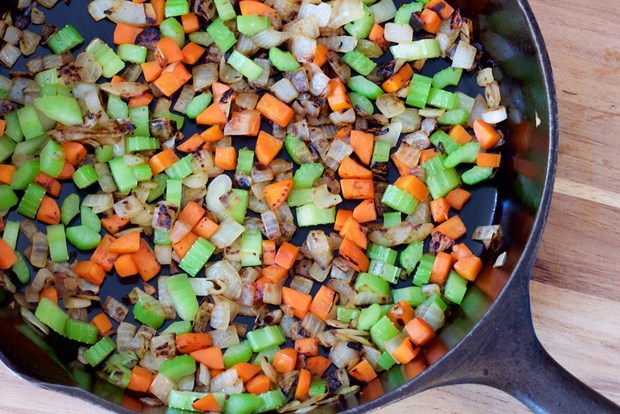Modern
cuisine tends to discard all those pronounced and added flavours likely to
cover the original taste of the main ingredient. Mirepoix is frequently accused
of being a prime offender.
Mirepoix
is a mix of gently fried diced vegetables used as a flavour base for cooking. A
well-balanced mirepoix calls for one carrot, one celery stalk, one small white
onion and a clove of garlic, as well as some excellent extra virgin olive oil.
Apart from the garlic, the vegetables must be very finely chopped.
Whether
it consists of onion and oil, garlic and oil or a mix of these ingredients
enriched with vegetables and spices, there is always a fear that they will
“dominate” the final flavour of the dish. While this is partly true, it must
also be said that the taste and aroma of mirepoix is an integral part of
traditional cuisine and therefore deserves due respect.
It
is all a question of learning how to adjust the flavour intensity of these
ingredients. Once again, science can come to our aid.
Onion mirepoix
Let's
start with the onion based mirepoix. The chemical composition of the onion is
mostly made up of water (92%). However, this is followed by 5.7% of sugar and
1% of proteins. You should know by now that sugar and protein are the two
components necessary to provoke the Maillard reaction (the chemical reaction
that gives browned food its distinctive flavour). We are used to seeing it take
place with meat but, in actual fact, onion is one of the few vegetables which
lend themselves to triggering it without the addition of anything else.
The
Maillard reaction is not only affected by the temperature, which must be high,
but also by the pH in the environment. The higher it is, the more intense the
reaction will be. This results in our onion becoming browner in colour and
sweeter in taste. For our purposes, we just need to add a pinch of bicarbonate
of soda to the sliced or chopped onion. The more bicarbonate we add, the faster
the reaction will be, resulting in a less “pronounced” taste. Take care not to
exaggerate though: too much bicarbonate would make our mirepoix unpleasant to
eat!

Source: The Cooking Dish
Garlic mirepoix
The
same principle also applies to garlic, as its composition reaches values of 8%
of sugar and 1% of protein, with an 80% of water. It is not surprising
therefore that it is generally easier to burn garlic than onion: you just have
to forget it for a second and the Maillard reaction goes too far!
So
to get the most out of your garlic, it is advisable to take a few precautions,
also because it is much more aromatic than onion. First of all, do not chop it
but use it whole or, at most, cut in half. Many cooks use it with the skin on
but in this case, the aroma is almost imperceptible. It is a much better idea
to cut it in half and remove the green inner shoot, which contains the greatest
concentration of those substances giving garlic its characteristic taste.
The perfect mirepoix
Having
learned these few simple rules, it is now time to find out how to make an
excellent mirepoix.
Remember
that a mirepoix must not be fried but gently stewed. This is why the vegetables
must go into the pan together with the oil (and bicarbonate of soda). The heat
must be low and the ingredients should “sweat” slowly.
Do
not be tempted to add more oil: all you need is enough to stop the vegetables
sticking to the pan and the right amount of this quantity of vegetables is
about one spoonful. This will also help you to mitigate the assertive flavours
of the mirepoix.
Anything
else? Use a wooden spoon to mix the ingredients for at least fifteen minutes.
If the vegetables start to sizzle excessively, lower the heat or add a drop of
water (no wine, since this would add aromatic notes which would cover the taste
of the vegetables). How can we use this delicacy? For serving on some excellent
toasted bread, even cold, with a pinch of salt and pepper. Simplicity first and
foremost.
By FDL